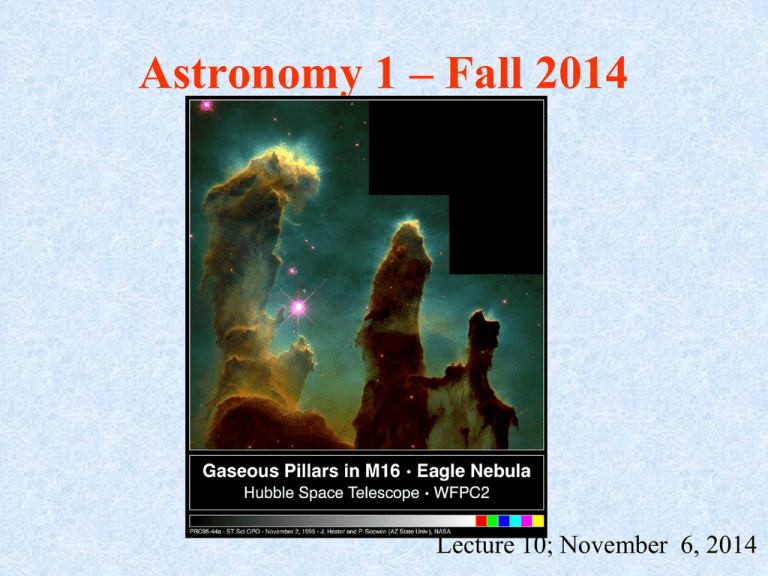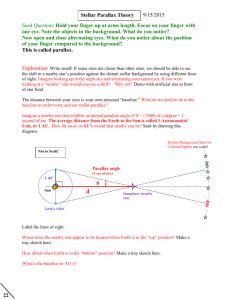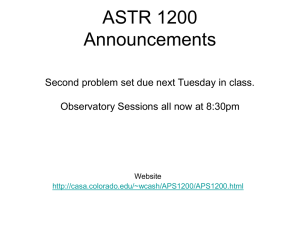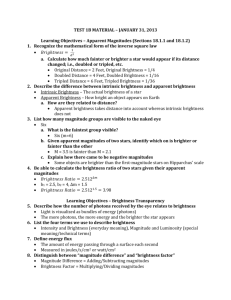Lecture10
advertisement

Astronomy 1 – Fall 2014 Lecture 10; November 6, 2014 Next Thursday! • Astro 1 Observing Session (Optional, Just for Fun) • WHEN: November 13th at 7-9pm • • • Same time Nov. 20th if the 13th is cloudy WHERE: Broida rooftoop; take elevator to 6th floor. Turn right as you exit the elevator. Go up the stairs. A TA will great you. WHAT: 3 Celestron C8 Schmidt-Cassegrain telescopes and one C11. • • • Andromeda Galaxy, Uranus, Mars, Crab Nebula, Pleides, etc. Help identifying the Celestial Equator, NCP (& Polaris), and the Ecliptic Constellations: Pegasus, Taurus, Summer Triangle, Orion, etc. • Why won’t you be able to view the moon? Previously on Astro-1 • The Sun – Internal structure – Energy source – Neutrinos and the solar neutrino problem – Sunspots and the sun cycle Today on Astro-1 • • • • • Introduction to stars Measuring Distances Inverse square law: luminosity vs brightness Colors and spectral types Masses of stars The closest stars to the sun. But how do we know the distance to them? Parallax Parallax measuring the distance to a star d = 1/p p = parallax in arcsec d = distance in parsecs 1 pc = 3.26 ly Parallax measuring the distance to a star d = 1/p p = parallax in arcsec d = distance in parsecs 1 pc = 3.26 ly Remember 1pc is the distance at which 1AU subtends 1 arcsec Example A star has a parallax of 0.1”. What is its distance? d = 1/p p = parallax in arcsec d = distance in parsecs d = 1/0.1=10 pc Question 20.1 (iclickers!) •Consider two stars, star 1 and star 2. Star 1 has a parallax of 0.05 arcsec. Star 2 has a parallax of 0.40 arcsec. How far away are the two stars? •A) Star 1: 5 pc, Star 2: 40 pc •B) Star 1: 1/5 pc, Star 2: 1/40 pc •C) Star 1: 10 pc, Star 2: 25 pc •D) Star 1: 20 pc, Star 2: 2.5 pc To put in perspective: If 1pc = distance from SB to NYC, distance from Sun to Earth ~ 10m! Less than this room! Inverse square law determining the luminosity of a star b = L/4πd2 b = brightness of star as we see it L = luminosity of star (wattage) d = distance to star The Inverse-Square Law Radiation from a light source illuminates an area that increases as the square of the distance from the source. The apparent brightness decreases as the square of the distance. The brightness at d = 2 is 1/(22) = 1/4 of the brightness at d = 1, and the brightness at d = 3 is 1/(32) = 1/9 of that at d = 1. Question 20.2 (iclickers!) •At the distance of the Earth from the Sun (1 AU) the intensity of sunlight is 1370 watts/m2. What is the intensity at the distance of Saturn from the Sun (10 AU)? A.13,700 watts/m2 B.1370 watts/m2 C.137 watts/m2 D.13.7 watts/m2 The Stars distances – from parallax luminosites – from b = L/4πd2 temperatures — from color and spectrum Hot Cold O B A F G K M L T Spectra of stars with different surface temps Spectra of stars with different surface temps Hydrogen absorption line: electron jumps from n = 2 to n = 4 orbit Spectra of stars with different surface temps If surface temperature is low, few hydrogen atoms have their electron in the n = 2 orbit: hence no absorption Spectra of stars with different surface temps If surface temperature is high, most hydrogen atoms have lost their electron completely: hence no absorption Spectra of stars with different surface temps If surface temperature is not too hot and not too cold, many hydrogen atoms have their electron in the n = 2 orbit: hence strong absorption Question 20.3 (iclickers!) •A star has a radius half of that of the Sun and a luminosity equal to 60% of that of the Sun. What’s the star’s surface temperature? The surface temperature of the Sun is 5800K. A.7220 K B.6650 K C.4660 K D.3610 K The mass of stars To determine stellar mases we rely on binary star systems. As seen from Earth, the two stars that make up this binary system are separated by less than 1/3 arcsecond. For simplicity, the diagram shows one star as remaining stationary; in reality, both stars move around their common center of mass http://astro.ph.unimelb.edu.au/software/binary/binary.htm H-R diagram with masses The main sequence is a mass sequence! Summary • • • • • Parallax is a tool to measure distances The Inverse-Square Law relates luminosity and brightness Low luminosity stars are more common than more luminous ones Colors and spectral types measure a star’s temperature The Hertzsprung-Russell (H-R) diagram is a graph plotting luminosity vs temperature • Most stars belong to the main sequence. Other important classes are giants, supergiants and white dwarfs. • Spectral typing can be used to determine distances • Masses can be determined for binaries. The main sequence is a mass sequence!! Homework (Due 11/10/14) • On your own, answer all review questions in ch 17. • For TAs, do 17.36, 17.47, 17.52, 17.66 • Guest lecturer on 11/13/2014 will be Iair Arcavi. Please come!











